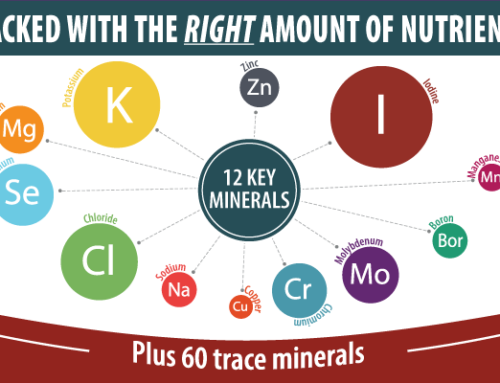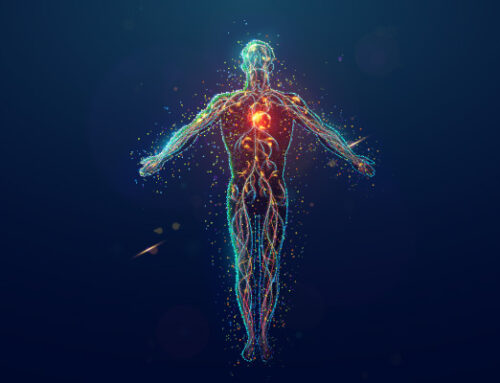You probably know that calcium is necessary for strong, healthy bones. But in your rush to ensure you are getting enough calcium in your diet; you may have overlooked an equally important mineral—magnesium. Like calcium, magnesium is an essential mineral. And like calcium, magnesium also contributes to strong bones. However, unlike calcium, many Americans have not heard of magnesium and are not aware of just how important it is. Magnesium has been dubbed “the forgotten mineral” because it is often overlooked in favor of calcium. But overlooking magnesium can have serious health consequences. Research shows that besides reducing one’s risk of osteoporosis, magnesium also lowers one’s risk of heart attack and stroke and reduces migraines. Magnesium is critical for a healthy pregnancy, and magnesium has a role in proper lung health. Here is a primer on magnesium, including how much you need, and the likelihood that you are not getting enough.
Magnesium, The Spark of Life
If you are one of the millions of Americans who have never heard about magnesium, you are not alone. “Calcium, because it is the most abundant mineral in the body, has become ‘the star,’” writes Carolyn Dean, M.D., N.D., in her book The Miracle of Magnesium. “Even though research has accumulated on magnesium over the past four decades, it has never been adequately publicized and discussed,” she adds.
So, what, exactly, is magnesium and why is it so important to health? Magnesium is an essential mineral. It is one of seven macro minerals (meaning it is required in relatively large amounts), including calcium, potassium, sodium, chlorine, phosphorous, and sulfur. “About 60 to 65 percent of all of your magnesium is housed in the bones and teeth. The remaining 35 to 40 percent is found in the rest of the body, including muscle, tissue cells, and body fluids,” writes Dean.
Magnesium performs a number of critical functions in the body, including helping muscles contract and relax, assisting in nerve function, and keeping heart rhythm steady and strong. In fact, every cell in your body needs magnesium. One of magnesium’s most critical functions is energy production. Your body’s cells need magnesium to activate ATP (adenosine triphosphate), which is the primary energy source your body uses. “Without magnesium, there is no energy, no movement, no life. It’s that simple,” writes Dean.
Besides energy production, “magnesium is directly necessary to the enzymes that break down glucose (blood sugar), it controls the production of cholesterol, makes nucleic acids such as DNA, and breaks down fats,” adds Dr. Mildred Seelig, M.D., M.P.H., a researcher who has studied magnesium for most of her adult life, and is the co-author of the new book The Magnesium Factor.
A Nation Low in Magnesium
Several national and government studies have found that most adult American men and women do not get enough magnesium in their diet. According to some researchers, the average American adult consumes 76 percent of the Recommended Daily Allowance (RDA) of magnesium. These experts believe that up to 75 percent of the U.S. population obtains less than the RDA. Children and teens—especially teenage girls—are at risk of not getting enough magnesium. A recent study by the Food and Nutrition Service of the USDA (United States Department of Agriculture) found that only half to two-thirds of children get enough magnesium. For adolescent and teenage girls, fewer than 15 percent consumed the RDA. This nutritional shortfall can have serious health repercussions.
Related article: Magnesium Deficiency – Needs for Magnesium Not Met in Most People
Can Magnesium End PMS?
Could a magnesium supplement (pill form or liquid magnesium) end the painful symptoms of premenstrual syndrome (PMS)? Yes, say some researchers. Not only have low levels of magnesium been found in women with PMS, but several studies have shown that magnesium supplements can lessen the severity of PMS. In one double-blind, randomized study, women with PMS received a placebo or 360 milligrams of magnesium three times a day from day 15 of their menstrual cycle to the onset of their period. Magnesium performed better than placebo in some measures related to premenstrual mood changes. In a separate study of 192 women who took 400 mg of magnesium daily, 95 percent reported less breast tenderness and weight gain, 89 percent suffered less nervous tension, and 43 percent had fewer headaches.
Related article: Magnesium and Mom – Risks of Low Magnesium During Pregnancy
Magnesium Guide for Every Age
Magnesium is important throughout each stage of life. For children and pre-teens, magnesium (together with calcium) is needed for tooth and bone formation and growth. Research also shows that magnesium is needed for physical and cognitive development.
Related article: Micronutrients and Brain Function
Throughout the teens, twenties, and thirties, women need magnesium to help build strong bones and prevent osteoporosis. For pregnant women, liquid magnesium may ensure a healthy pregnancy. Some research shows that women with optimal intakes of magnesium had lower rates of preeclampsia, premature labor, and had bigger, healthier babies.
After age 40, magnesium is important for both men and women. It can help regulate blood pressure and blood sugar levels and normalizes heart rhythm, reducing the risk of diabetes, heart attack, and stroke.
| Life-Stage | Children |
|---|---|
| Ages 1 – 3 | 80 mg a day |
| Ages 4 – 8 | 130 mg a day |
| Ages 9 – 13 | 240 mg a day |
| Life-Stage | Men | Women | Pregnancy | Lactation |
|---|---|---|---|---|
| Ages 14 – 18 | 410 mg | 360 mg | 400 mg | 360 mg |
| Ages 19 – 30 | 400 mg | 310 mg | 350 mg | 310 mg |
| Ages 31 + | 420 mg | 320 mg | 380 mg | 320 mg |
When the average American obtains only 76 percent of the RDA of magnesium needed to support critical body functions, moderate to severe health problems arise over time. Some of the symptoms commonly associated with low magnesium include confusion, irritability, fatigue, muscle cramps, heart arrhythmias, high blood pressure, migraine headaches, and, for women, premenstrual syndrome. Seelig, as she discusses in her book, The Magnesium Factor, strongly believes that heart disease is the net result of not getting enough magnesium throughout one’s life.
Related: Magnesium for Asthma and Lung Health
Why Americans Are not Getting Enough Magnesium
So if magnesium is so important, why are so many not getting enough? There are several factors behind the widespread magnesium shortfall, explains Seelig, but America’s ultra-processed, high-sugar, high-salt, fatty diet is mostly to blame. Many of the foods Americans eat such as grains, vegetables, and other foods, undergo extensive processing (milling, blanching, boiling, etc.), which removes magnesium. “For wheat, a major staple of our processed-food diet, refining out wheat bran and germ lowers the magnesium content by 80 percent,” writes Seelig. Further, chemicals used in the preparation of frozen vegetables, and boiling vegetables for prolonged periods of time also significantly lowers magnesium content.
Eating too much fat, sodium, sugar, and protein, and drinking alcohol, also threatens the amount of magnesium in your body. Fat blocks the body’s ability to absorb magnesium as well as other minerals such as calcium. Eating a high-protein diet, such as the Atkins diet, says Seelig, also increases the need for magnesium. Salt, sugar, and alcohol cause the kidneys to excrete magnesium.
Kids are especially at risk for magnesium deficiency because they are often the biggest consumers of soda pop. According to recent USDA figures, 56 to 85 percent of children consume soda on a given day. Teenage boys are especially heavy soda-pop drinkers, with over a third reporting they drink more than three servings a day. Soda contains exorbitant amounts of sugar, which poses a number of health issues for kids. The standard twelve-ounce can of cola, for instance, contains nine teaspoons of sugar. According to Seelig, the high-sugar content of soda causes the kidneys to excrete magnesium. Further, some sodas (such as cola, diet cola, and Dr. Pepper-type drinks) also contain phosphates, which bind to magnesium, blocking its absorption in the body. The result is that many kids are not getting the magnesium they need to support healthy growth and development. In addition, excess consumption of soda in children has been linked with tooth decay, obesity, diabetes, and osteoporosis.
Some medications also increase your need for magnesium. Birth control pills, diuretics, insulin, and other antibiotics, all affect how much magnesium you need. According to Seelig, “Many diuretics prescribed for high blood pressure increase magnesium loss in the urine. Some antibiotics and digitalis long used for heart pain can increase magnesium need. Estrogen found in both birth control pills and hormone replacement therapy increases adrenaline which, in turn, increases magnesium need.”
Related article: Many Medications can Induce Electrolyte Deficiency
Taking a calcium supplement that is not balanced with magnesium can drain your magnesium stores. “Calcium is an important nutrient,” writes Seelig. “But your body also needs magnesium to properly utilize calcium.” If you are currently taking a calcium supplement to prevent osteoporosis, Seelig recommends switching to a calcium and magnesium supplement.
Building Better Bones
Osteoporosis, a condition where bones become porous and break easily, affects more than 10 million American women and 2 million men, according to the National Osteoporosis Foundation.
You have probably heard the phrase, “Milk does a body good.” Although calcium is an important mineral—its role in building and strengthening bones is undisputed— bones need other minerals and vitamins as well, including magnesium. Besides increasing the body’s ability to absorb calcium, magnesium (or liquid magnesium) helps bones by making them more flexible and, thus, less prone to fracture. According to Seelig, “Calcium is mostly found in the bones, and gives them much of their hardness; magnesium is found mainly in soft structures, like bone matrix, and gives bones some flexibility and resistance to brittleness.”
Food Sources of Magnesium
| Food Group | Examples | Magnesium/ 3.5 oz (100 g) serving (mg) |
|---|---|---|
| Cereals (Dry) | Bran (100%) | 473 |
| Nuts (Raw) | Almonds, cashews, peanuts | 180 – 296 |
| Legumes | Tofu, soybeans, butter beans | 86 – 103 |
| Fruits (Raw) | Dates, raisins, bananas | 29 – 35 |
| Vegetables (Raw) | Corn, broccoli, peas | 24 – 37 |
| Meats | Turkey, Fish, Pork, Chicken | 21 – 24 |
| Dairy | Cheddar cheese | 28 |
| Beverages | Whole milk, wine | 10 -13 |
According to Dean, magnesium deficiency is quite common in women with osteoporosis. Dean believes that not getting enough magnesium alters bone and mineral metabolism, which leads to bone loss. Dean points to studies showing that women with osteoporosis increased their bone density while taking magnesium supplements. In one study, postmenopausal women with osteoporosis who took 250-750 mg of magnesium daily not only halted bone loss but, in some women, increased bone density. “Without any added measures, eight percent of these women experienced a net increase in bone density,” she writes.
Research has uncovered just how magnesium and liquid magnesium improves bone health. First, it regulates the transport of calcium into the bone. Second, magnesium stimulates calcitonin, a hormone that helps preserve bone structure, by drawing calcium out of the blood and tissues back into the bones. Third, it also helps convert vitamin D, another nutrient important for strong bones, into its active form, so it enhances calcium absorption.
Banishing Migraines
Twenty-five million Americans suffer from migraines, and women are more vulnerable to them than men. Migraines strike women (18 percent) more than men (6 percent). “Migraine headaches occur when the blood vessels in the brain spasm and constrict,” as indicated by Chris Meletis, N.D., “Soon after this constriction occurs, the blood vessels then reflexively open or dilate. When the vessels become dilated, they occupy more space in the brain, which activates nearby pain receptors.” The result is the stabbing pain, nausea, and sensitivity to light and sound many migraine sufferers report.
“Recent evidence suggests up to 50 percent of migraine patients have lowered levels of magnesium during an acute attack,” adds Meletis. Dean believes that low magnesium is one piece of the puzzle; however, she also believes that high estrogen levels contribute to migraines as well, which may explain why migraines affect women more than men. “In non-menopausal women, estrogen levels rise just before a woman’s period, which causes magnesium to shift from the blood into the bone and muscles. As a result, magnesium levels in the brain are lowered.”
Magnesium has also been shown to alleviate migraines by relaxing blood vessels and allowing them to dilate, reducing the spasms and constrictions that can cause migraines. In addition, Dean discloses that magnesium relaxes muscles, prevents the buildup of lactic acid, and regulates the action of neurotransmitters and certain inflammatory molecules, which are all related to migraines.
Related article: How to Get Rid of a Charley Horse
Preventing Heart Attacks
“Magnesium deficiency is the basis of almost all of the heart disease epidemic that consumes so many of our health-care dollars,” states Seelig in The Magnesium Factor. It sounds like a bold claim, but Seelig, who is in her mid-eighties, has spent most of her adult life studying magnesium’s effect on the heart. In fact, she’s contributed several research reviews intricately detailing the effect of magnesium in several heart-related conditions including angina (chest pain), arrhythmia (irregular heart rhythm), heart attack, heart valve disorders, high blood pressure, and sudden death due to heart attack or stroke.
Magnesium’s role in heart health is both complex and multifaceted. Your heart is the hardest working muscle in your body. It contracts 70 to 80 times per minute, pumping blood, which delivers oxygen and nutrients, throughout your body. Heart muscle contains more magnesium than any other muscle in the body. Magnesium helps the heart contract and relax before and after each heartbeat. It also thins the blood (similar to aspirin), reducing the risk of clots, which can cause a heart attack.
One of the disorders involved in heart disease is the hardening of the arteries or arteriosclerosis, which occurs when the arteries and blood vessels become thick, stiff, and brittle. Over time, arteriosclerosis causes blood pressure to soar and arteries to narrow, cutting off blood flow to the heart and other parts of the body. According to Seelig, magnesium keeps blood vessels soft and flexible, preventing a buildup of plaque within the arteries.
Magnesium is truly the silent guardian of your heart, blood vessels, cells, and body,” Seelig writes.
This next section on Magnesium and its important Antioxidant functions was added from MRI’s Ion Health newsletter written by Val & Karie with Dr. Seelig
Magnesium and its Important Antioxidant Functions
Did you know that magnesium (Mg) deficiency can act as an oxidative agent? In addition to releasing free radicals, a lack of Mg can also negatively lower the status of other antioxidative enzymes in the body, which can leave one vulnerable to certain age-related diseases. According to MRI’s consultant, Mildred Seelig, M.D., M.P.H., numerous animal-based studies have shown that animals fed Mg-deficient diets are at increased risk of oxidative stress. Most of the damage caused by free radicals in Mg-deficient animals involves the endothelium, which is the inner lining of the blood vessels. Seelig states that endothelial dysfunction can result in hypercholesterolemia, thrombosis, increased adhesion of white blood cells to the lining of arteries, and arterial constriction of hypertension, including many age-related diseases.
Related article: Minerals and Immune Function
In one study, researchers found that animals who were Mg deficient were more susceptible to oxidative stress and that their tissues were more susceptible to peroxidation. A separate study involving mice found that as levels of Mg in the blood dropped, so, too, did levels of key antioxidant enzymes such as superoxide dismutase. The study’s researchers concluded that changes in the antioxidant enzyme activities within the heart contributed to oxidative stress, which may help explain why cardiac lesions are often observed during Mg deficiency. Sources: Rayssiguier Y, Durlach J, Gueux E, Rock E, Mazur A. Magnesium and ageing. Experimental data: importance of oxidative damage. Mages Res 6:36-378, 1993. Kuzniar A, Kurys P, Florianczyk B, Szymonik-Lesiuk S, Pasternak K, Stryjecka-Zimmer M:The changes in the antioxidant status of heart during experimental hypomagnesemia in balb/c mice. Biometals 14:127- 133,2001.
Rx for Health and Longevity
So, what can you do to ensure that you and your family are getting enough of this vital nutrient?
First, say Dean and Seelig, eat a balanced diet that includes foods rich in magnesium such as leafy green vegetables, legumes (beans and peas), nuts, seeds, and certain dried fruits, and whole grains (see sidebar on page 3 for more magnesium-rich foods). Second, eliminate or reduce your consumption of alcohol, white sugar, white flour, fried foods, and trans-fatty acids (found in margarine as well as baked or fried processed foods). These foods either deplete magnesium from your body or provide such low levels to be of any nutritional value. Third, reduce your intake of salt. The average American adult consumes four to six grams of sodium per day, which is significantly higher than the 1.1 to 3.3 grams recommended by the National Research Council. High intakes of sodium have been shown to inhibit the absorption of magnesium. A fourth step, especially if you have children or teens, is to eliminate soda pop. Soda is high in sugar and does not provide any vitamins or minerals. Instead of soda, offer kids and teens orange juice, water, or milk. Milk, for instance, is a rich source of calcium, but it also provides small amounts of magnesium too.
Finally, magnesium supplements are an option, but they are not for everyone. People with kidney disease should not take magnesium supplements.
*This brochure is for informational purposes only and does not constitute an endorsement of MRI’s products. The Food and Drug Administration has not evaluated these statements. This product is not intended to diagnose, treat, cure, or prevent any disease.
Supplementing with Magnesium
Choosing which magnesium (or liquid magnesium) supplement is best can be confusing because there are so many types to choose from. Here is a brief rundown of the four most popular types.
“As a general rule, when taking magnesium supplements, start out at a low dose and gradually build it up,” writes Seelig. But be sure not to exceed the recommended daily intake. In large doses, magnesium supplements cause diarrhea. If you experience diarrhea while taking magnesium supplements, Seelig advises cutting back on the dosage. People who are on antibiotics should not take a magnesium supplement with their antibiotics. If you are taking insulin or heart medication, check with your doctor first. Those with kidney disorders should not take a magnesium supplement.
MAGNESIUM OXIDE:
This is the most common and inexpensive type, but it can also be difficult for some people to digest. Magnesium oxide supplements require stomach acid, and, as you grow older, you produce less hydrochloric acid. Elderly people or those who do not produce enough stomach acid should choose a different form of supplement.
MAGNESIUM CHLORIDE:
This supplement is usually a little more expensive than oxide, but it is easier to digest, which should be helpful for those who do not produce enough stomach acid.
MAGNESIUM SULFATE:
Epsom salts are the best-known source of magnesium sulfate.
MAGNESIUM CITRATE:
Citrate forms are usually more expensive than chloride forms. Magnesium citrate is a chelated mineral, meaning it is paired with an amino acid. Citrate is said to be easier to absorb, but it is more expensive.
MULTI-VITAMIN/MINERAL SUPPLEMENT:
“As a general rule, these do not contain much magnesium,” writes Seelig. “Even those labeled “super-supplements” rarely have more than 125 mg of magnesium per tablet. This can be enough to fill many persons’ magnesium gap but is too low for others.”






